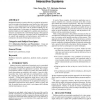Free Online Productivity Tools
i2Speak
i2Symbol
i2OCR
iTex2Img
iWeb2Print
iWeb2Shot
i2Type
iPdf2Split
iPdf2Merge
i2Bopomofo
i2Arabic
i2Style
i2Image
i2PDF
iLatex2Rtf
Sci2ools
85
Voted
EICS
2009
ACM
2009
ACM
Flexible and efficient platform modeling for distributed interactive systems
Distributed interactive systems often rely on platform information, used for example when migrating a user interface to a small-screen device, or when opportunistically recruiting available peripherals. There has been to-date little work in platform modeling for distributed applications. In this paper, we demonstrate that distributed platform models are well supported by a publish and subscribe architecture accompanied by a rich filtering language. This approach allows organic construction of networks with no centralized locus of control, high scalability and fault-tolerance, and flexible customization to the needs of heterogeneous device types. Categories and Subject Descriptors H.5.3 [Information Interfaces and Presentation]: Group and Organization Interfaces--Computer-supported cooperative work. General Terms Human factors, performance, design Keywords Distributed interactive applications, platform model, groupware toolkits
Related Content
| Added | 16 Aug 2010 |
| Updated | 16 Aug 2010 |
| Type | Conference |
| Year | 2009 |
| Where | EICS |
| Authors | Xiao Feng Qiu, T. C. Nicholas Graham |
Comments (0)

